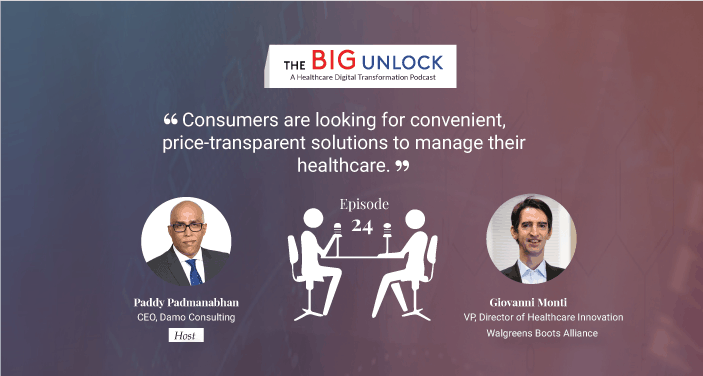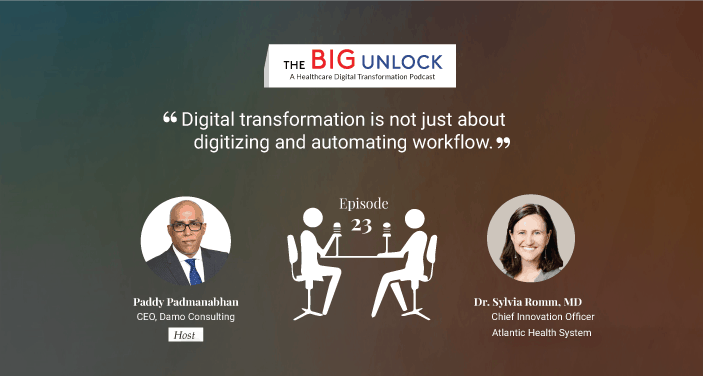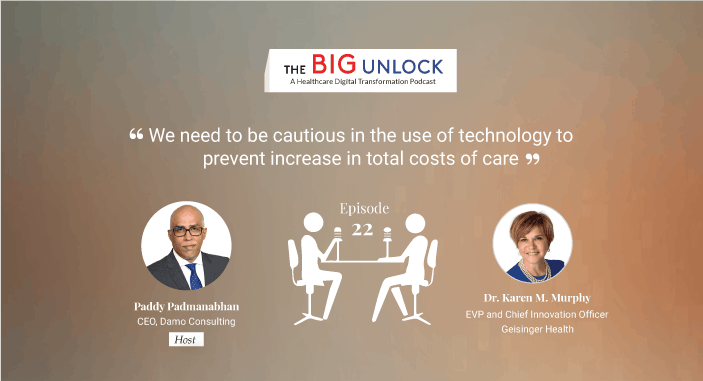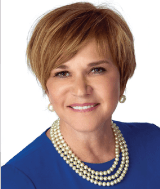Episode #24
Podcast with Giovanni Monti, VP, Director of Healthcare Innovation, Walgreens Boots Alliance
 Hosted by Paddy Padmanabhan
Hosted by Paddy Padmanabhan 
In this episode, Giovanni Monti discusses his current role and how the digital healthcare innovation group at Walgreens is focused on bringing new and sustainable innovative solutions to consumers.
Innovation at Walgreens is to have consumers manage their healthcare in a convenient and cost-effective way with great outcomes. It is all about delivering care to consumers when they want it, how they want it, and where they want it. Some eight million customers walk through a Walgreens store every day. Through their recently released Find Care app, Walgreens has started providing a range of personalized and localized healthcare services to consumers. Going well beyond the traditional e-prescription function, the app is a digital front door that delivers services from a curated set of 30 partners that can be accessed anytime anywhere with price transparency.
Giovanni’s current role at Walgreens is to focus on extending these partnerships by working with the right innovators at the right time in their product and market growth.
Welcome to the big unlock podcast where we discuss digital transformation and emerging technologies in healthcare. Here are some of the most innovative thinkers and leaders in healthcare and technology talk about how they are driving change in their organizations.
Paddy: Hello everyone and welcome back to my podcast. This is Paddy and it is my great privilege and honor to introduce my special guest today Giovanni Monti, Vice President and Director of Healthcare Innovation for Walgreens Boots Alliance. It’s very rare for me to actually do a podcast interview in person and this is one of those rare occasions. I am at the Walgreens Boots Alliance corporate headquarters in Deerfield, Illinois. Giovanni, thank you so much for joining us and welcome to the podcast.
Giovanni: Thank you Paddy. Great to be on your podcast and doing it in person.
Paddy: Very good. So, let’s get started. Tell us a little bit about your current role and the digital Healthcare Innovation Group at Walgreens.
Giovanni: Sure absolutely. So, Walgreens and Walgreens Boots Alliance in particular is basically the largest pharmacy networking in the world. And so, in my role I’m really focused on extending the relationship that customers have with their pharmacies and pharmacists from the pharmacy to overall healthcare. And to do that not just in store but where and when they want it with the view of helping the customers better manage their healthcare. We do that by sometimes developing new pharmacy services delivered in store. Other times developing a digital innovation that are then delivered in a nominal channel way and it’s really like all the innovations a great team effort not only my team that which is between Seattle, Chicago, and the U.K. But the overall company from the stores to everyone else as well as partners because through our innovations we also bring lots of partners and innovators to market.
Paddy: And we’ll cover a lot of this as we go along in the conversations. You mentioned a couple of things. Clearly your focus is to take your retail consumer relationships to an online relationship. That’s one of your focus areas and you also mentioned healthcare is all about delivering care to consumers when they want it, how they want it, and where they want it. I know that Walgreens made a big digital splash earlier this summer with your new app you want to share a little bit about the app.
Giovanni: Sure. Absolutely. So, the Walgreens app was already a very successful app that Walgreens customers are utilizing on daily basis to manage their prescriptions. And what we’ve really done is a year ago we started extending that app, as I was saying earlier, enabling consumers to manage their healthcare more broadly. And so, what we’ve launched is – Find Care – which is a new solution available on the Walgreens app and on Walgreens.com and it’s a platform enabling individuals to connect with healthcare solutions based on where they are and based on their healthcare needs. And we’ve designed it in a way that it’s totally customer centric and on Find Care then consumers would find. Of course, all the Walgreens services that we deliver but also a curated selection of partners. And these solutions deliver by these partners. Sometimes in-store other times purely digital in a very consumer friendly way. We launched it a year ago approximately and then we keep adding new partners and new solutions based on what customer needs and based on what we learned from the eight million customers that goes through Walgreens stores or digital on a daily basis.
Paddy: I will come to the partnerships in a minute. Could you tell us what was the need you perceived in the market as you started thinking about this app for the consumers.
Giovanni: Yeah absolutely. So, what is happening in healthcare, as you are covering in so many of your podcasts, is that consumers are looking for convenient solutions they want or sometimes need to be more involved in managing their healthcare costs some time are escalating. So, there was a need to connect individuals to more convenient price inspiring solutions. And we had the opportunity of doing it. Given our great footprint and daily traffic as I say in stores and digitally. And we already had a great starting point because through Walgreens we have lots of partnerships on different customer needs in different regions with different partners whether it’s you know labs, and urgent care, and primary care, or other partners. So, with Find Care, we aim to address these customer needs of a convenient transparent access to their health.
Paddy: Let’s talk about the partnerships right. The Find Care app which by the way is on my phone as well. I’m a Walgreens customer and I pick up my prescriptions using the Walgreens app and now I have Find Care which gives me a whole menu of offerings. I’m going to let you actually talk about the offerings and you mentioned a curated list of partners so tell me about the curation process. Well firstly how did you curate the services that you wanted to offer on the app and then how did you curate the partners who are going to offer it on your behalf on your digital property.
Giovanni: Yeah absolutely. So, we want to make sure that customers have access to proven reliable solutions to manage their healthcare. And we look at what the customer needs are, what the various innovations are, what is available on the market, but maybe not really utilized because of lack of direct access to consumers. And we come up with a prioritization for the Find Care development in terms of adding new services and new partners. As we identify target areas then we aim to start with the leaders in that area. And again, the starting point was really great because when we launched it, we had already 17 partners on board. Starting with who was already working with us in store maybe with co-located clinics, urgent care, online doctors from MDlife to Providence, Narcolepsy, etc. But then quickly Find Care has already become a way to based on the customer needs attract to Walgreens new partners that deliver their solutions. So for instance over the past few months we’ve announced the extension of Find Care to chronic condition management, with now Propeller available on Find Care to manage asthma and COPD or Dexcom in continuous glucose monitors. So, there is a whole stream of solution providers. There are also new care delivery models whether it’s doctor or house calls like Heal. And in the west or tele derma solutions in this case nationally. And then we also look at national versus local in a way because depending on the service and depending on the partners which is what makes sense. So we’ve also added in certain geographies where we didn’t yet have a great local offering through Find Care more partners like Houston Methodist or other national solutions as well. So that’s really the principle of how we develop the partnership on Find Care.
Paddy: And now how many partners are you right now?
Giovanni: Approximately 30 but it’s growing quickly. Yeah. So as of today, 30 but maybe.
Paddy: Maybe the next time when we speak it will be much bigger than that.
Giovanni: Some offer more than one service because they might have urgent care and telehealth through Find Care for instance.
Paddy: So is it fair to say the focus of the offerings is routine primary care but also urgent care. Are these the two main focus areas?
Giovanni: You know it goes all the way to the beauty of a platform like Find Care is that it really enables deep personalization and localization. So, we are adding services that we know will be valuable only for certain segment of our customers. But when they are there would be very valuable. So, we’ve gone all the way to. tele dermatologist I have mentioned earlier or even second opinion is already available on that on Fine Care. So clearly telehealth, urgent care, primary care is some of the focus areas, but we like any internet platforms we can manage the long tail.
Paddy: So, let me switch topics here for a minute and talk about the data that’s powering many of these applications. Now you mention you have a very strong foot traffic in your store so obviously you have a very strong understanding of your retail consumers and retail healthcare consumers. Now to build more of a healthcare relationship you probably need other data sources as well about the clinical and their claims history and so on and so forth. Can you talk a little bit about your data strategy as it relates to building out new products and engaging more with your patients?
Giovanni: Yeah absolutely. So, the way we look at it is that we are totally focused on the customers interests. Walgreens and the other Walgreens Boots Alliance companies in other countries are a very trusted and pharmacies are a very trusted counterparty or healthcare stakeholder. And so, there is a great level of trust that consumers have in interacting daily with us in store and digitally. We with Find Care continue to be totally focused on the customer’s interests. So as Fine Care evolves both from a product perspective as well as partnerships and as a deeper data strategies and opportunities are becoming possible, we prioritize and decide the entire entirely the art of the possible enabled by data centered on the customer interest.
Paddy: And I did notice that the Find Care app all the services that are offered on the app. There’s actually a price indicated as well. So I assume that it was a conscious decision on your part to list all the prices for all of the services so that consumers had price transparency when it came to your store just like they would for anything that they bought at the store even though it’s a digital health offering and that’s kind of a unique and interesting thing as well.
Giovanni: Yeah. No absolutely we believe it’s where we know from customers feedback and insight that it’s something they very much look for and we’re very focused through the Find Care platform on building the necessary transparency together with the convenient access solutions.
Paddy: So the applications like Find Care are what I refer to as digital front doors. This is like a digital storefront for consumers to come in and veil of broad range of health care services. Walgreens is not the only company that is launching these kinds of digital front doors. A lot of traditional healthcare providers as well as non-traditional healthcare providers are getting into the business and so the competitive landscape for primary care, urgent care type of services is evolving. Would you like to comment on what you see as the current state of the market as it relates to the emergence of digital front door type of offerings.
Giovanni: Yeah sure. So, it is absolutely an evolving framework in a way and with non-traditional players as well. And even I would say the traditional players are playing their role in non-traditional ways because it is possible today thanks to the evolution of a technology, data, interoperability, regulation depending on the countries et cetera to connect the customer and patient journeys in different ways. With Find Care and with the Walgreens network we are focused on enabling those new care delivery models and customer journeys without you know the unnecessary barriers between one and the other. So for instance a while ago almost a year ago we in Walgreens we launched a collaboration with Humana opening partners in primary care centers for seniors or with more recently announced one with VillageMD for primary care offering forum for adults and these collaborations. Of course, then as they go live they also go live on Find Care where there are many other evolving offerings as well. I think the principle that we must keep in mind and design to is the integrated journey where it’s possible between the various care delivery stakeholders and pharmacists and primary care and the rest which is what consumers are looking for in addition to price transparency.
Paddy: And you also have partnerships with hospitals I think Advocate Aurora is one of your partners. So, you I am assuming have a referral arrangement in place where your consumers were looking for more acute care type of services. You could refer them to one of your partners in your patient care network. Is that the intent?
Giovanni: So, it’s all built as I said earlier with customers first transparency, and choice, and consumers depending on where they are see different offers. Because in their geographies there might be certain partnerships and those will be different from other geographies like healthcare systems are across different states.
Paddy: How has the response been since. So, the app has been out there for what three months four months now?
Giovanni: The latest services yes leaner version with fewer partners and services now a year. Did the response. Look we’re really pleased with the response I would say. And what we were talking about partner so let’s continue that. We have almost doubled the number of partners and services available on Find Care in the first year which is a great sign of the interest that so many partners and healthcare innovators have in bringing through us proven healthcare innovations to market. Because again we have such a good connection credibility in daily flow of customers that we can truly help our customers partners. But also, the reaction from the stores and from customers has been very good with the colleagues in stores that I’ve learned they’ve gone through training and now have one place to go to find new solutions to recommend to consumers. Customers these stories they liked the most of a customer’s reaction is when they’re actually able to find the end to end solutions on Find Care may be in store where a colleague recommends them for a certain need to access the platform they do a consultation or access any of those services and are able to walk out of the store with their health need. So, which is pretty impressive. Whereas from a more if you on healthcare innovation and digital perspective we’re also quite happy that in less than a year we were already shortlisted as a Webby honoree which is a great start for a new digital.
Paddy: Yeah. Congratulations. Let me take a step back now you’re also the Director of Healthcare Innovation and this is clearly a very innovative new offering from Walgreens. Can you talk to us a little bit about how you define innovation? Every organization has a different definition. What is your definition of innovation? How do you define success metrics and how do you track? How do you measure success with innovation?
Giovanni: Yeah absolutely. So, I’ll repeat what I said earlier a bit because it’s really what we stand for in a way. We want to have consumers manage their healthcare in a convenient and cost-effective way and with great outcomes as much as possible. And so, for any innovations we are introducing we are very focused on that. We’re equally focused given our scale ON MAKING INNOVATIONS sustainable which then means that for all the stakeholders involved whether it’s the digital therapeutics or connected care companies bringing innovations or our networks and scaling them up etc. We want to ensure that we can serve the millions of customers and patients we have. And so, we are very focused on from the beginning designing innovations that have that level of sustainability. So again, given our scale. We also liaise a lot with the rest of the healthcare stakeholders or national healthcare systems. Because we know that when we succeed in innovations there is a profound impact on the local health care system. Just think it. I don’t know immunizations for instance a few years ago before they were available in pharmacy the landscape was totally different. And think of the profound impact it has had on care delivery. The role that we’ve had in adding these services in pharmacy. So, you know sometimes for smaller startups is easier to start because they have to worry a bit less about the implications at scale. We have the luxury of developing innovations in a group that is just in the U.S., 8 million daily customers. So, we feel that responsibility.
Paddy: Now of course Walgreens Boots is now much more than a U.S. Company it’s a global firm. And when you look at your company’s business in a global perspective and when you look at innovation pipeline and prioritizing innovation investments and taking care of customers’ needs in different global markets how do you really manage the tradeoffs and how do you really prioritize when it comes to managing let’s say consumer needs in Europe versus North America. How do you do that as an innovation group that’s responsible at an enterprise level?
Giovanni: Yeah. So, innovation happens everywhere. First of all, like in local communities with local contracting relationships with the local healthcare system and they maybe come up with a new way to deliver a healthcare service et cetera. And that’s fine. Absolutely. We can help scale some of those innovations. What we’re very focused on in my team in a way are the those innovations that are truly scalable across geographies because they build on common customer needs, common platforms et cetera. And I would say for instance the example of Fine Care is probably a good one.
Paddy: Yeah. And in addition to internal innovation do you have a formal program for looking at what’s going on out there in the marketplace. For instance, the startup ecosystem in the United States, digital health innovation ecosystems. Billions and billions in VC money that is going to fund startups that have very interesting ideas but of course they also come with a lot of risks. How do you really harness the external innovation in a way that it doesn’t put you at too much risk? But at the same time gives you the opportunity to tap into the innovation that is available. What are the tradeoffs there? How do you look at that market?
Giovanni: Yes. So, we are very active on the market with lots of different offices across my team and others are constantly speaking with the innovators. Let’s remember that innovations can come from you know startups as well as big leaders in their space. And we again are constantly speaking with innovators. At the same time, we’re very focused on the strategic priorities that we’ve identified based on our road maps and the customer needs because it’s important to work with the right innovators and at the right time to then really help them grow at scale. And sometimes it’s better to wait and touch base again after six months or a year when the product roadmap, marketing roadmap whatever is better aligned in these dialogues and relationship with innovators for instance. I would also add you know we go from having added the propeller. A great example of a relatively new company to actually having introduced services on sleep with Philips which is almost the other scale of the size continuum.
Paddy: One of my earlier guests on my podcast put it this way. They said we look first internally to see whether the solution is available somewhere in the system. If you find a need in the market and if it isn’t available, we ask ourselves can we build it. Those with the resources that we have. And if the answer is no to that then we’ll go out and look whether such a solution is available out there in the market. And they of course do one more thing which is that if they really find it interesting solution then go out and put some venture capital money into the company themselves. Do you have a V.C. fund? Do you look at companies that way?
Giovanni: We’re really focused on bringing new solutions to consumers. That’s our DNA with the network we have, the role that we have in pharmacy and our network. And sometimes innovation is available. And however, they’re not where the customers are, and we can how that happen. So that is really our focus and the way we can create value for consumers as well as for innovators that want to scale up their innovations.
Paddy: That’s where we all said. Well we’re coming up to the end of our time here. Giovanni is there any closing thoughts anything that you would like to share maybe some new innovation that you’re working on that you’d like to share with us?
Giovanni: What I would say is first of all thank you again for the opportunity of being on your podcast. And I would say just go on Walgreens.com and check out Fine Care and see whether there is an opportunity for your company and healthcare system, solution providers, digital therapeutics, whatever it is to connect with our customers in a personalized targeted way. I was mentioning earlier Phillips, it’s the latest addition to the solutions that we offer via Fine Care with their smart sleep analyzer that providers personalized recommendations. There is a there is a lot that innovators can do with Fine Care and the Walgreens scale and network. There is a rich product roadmap and partnership roadmap. And I look forward to sharing other developments maybe in the near future.
Paddy: Yeah. And we’ll be back again, and we should touch base maybe six months to a year from now and I’m sure you’ll have a lot of new updates and lot of new innovations to talk about you on. Giovanni it’s been such a pleasure speaking with you. And once again thank you for hosting me at the Walgreens Boots Alliance global headquarters here in Deerfield, Illinois. And thank you once again. We’ll be in touch.
Giovanni: Thank you. My pleasure. Thank you.
We hope you enjoyed this podcast subscribe to our podcast series at www.thebigunlock.com and write to us at info@thebigunlock.com
About our guest
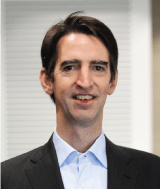
Giovanni leads healthcare innovation at Walgreens Boots Alliance (WBA), the first global pharmacy-led health and wellbeing enterprise. Prior to leading the healthcare innovation, Giovanni was Director of Corporate Development and M&A at WBA since 2012, with previous experience in corporate development, M&A, and management consulting.
Giovanni is a member of the Advisory Board of the Healthcare and Pharmaceutical Management Program at Columbia Business School, and holds a Degree in Economic and Social Sciences from Bocconi University, Milan, and both a Master in Business Administration (MBA) from Columbia Business School and a Master of International Affairs (MIA) from the School of International and Public Affairs, Columbia University, New York.
Recent Episodes
About the host
Paddy is the co-author of Healthcare Digital Transformation – How Consumerism, Technology and Pandemic are Accelerating the Future (Taylor & Francis, Aug 2020), along with Edward W. Marx. Paddy is also the author of the best-selling book The Big Unlock – Harnessing Data and Growing Digital Health Businesses in a Value-based Care Era (Archway Publishing, 2017). He is the host of the highly subscribed The Big Unlock podcast on digital transformation in healthcare featuring C-level executives from the healthcare and technology sectors. He is widely published and has a by-lined column in CIO Magazine and other respected industry publications.
Connect

